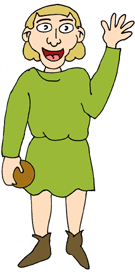|

|
|

in the Dark Ages

|
- Neither manuscripts
nor archaeology tell us much about British
and Saxon children, but we can work a
few things out.
- Some old drawings show
that Saxon children wore short tunics (a bit like a very long
t-shirt), tied at the waist. They did not wear cloaks like
grown-ups and had bob hair-cuts.
- Some documents indicate
that they often didn't wear many clothes at all. They must
have got very cold!
- Times were hard and many
children died of diseases, disabilities and accidents. Their
graves sometimes tell us a bit about their lives. Girls
sometimes wore simple necklaces or small brooches.
- A few children's graves
have contained toys: like a rattle, a fossil, some shiny
'fools' gold' or a worn & discarded brooch.
- Archaeologists have also
found leather balls and wooden spinning tops.
- Children made their toys
from whatever was available to them. They were probably mostly
made from things that have all rotted away. Later Medieval
documents tell us of hobby-horses and swords made of sticks,
boats made of bread and dolls made of cloth.
- There is one Saxon
drawing of a child playing with a hoop and stick. This game
was still popular in the early 20th century.
- A few documents tell of
other ways in which children liked to play back then: playing
in gangs, wrestling, acrobatics, playing musical instruments, singing,
doing animal impressions, playing on the beach. Not much has
changed.
- Some documents mention
children riding on sticks and copying grown-ups in other ways.
Like playing house or doctors & nurses today.
- Children often helped
grown-ups do daily chores, like plucking chickens or spinning
wool. Girls' graves sometimes contain weaving battens or
spindlewhorls which they used in their chores.
- Boys' graves might
contain knives or small spears. These were dangerous tools and
weapons but, in those days, boys had to learn to use them from
a young age.
- Only very rich children
went to school.
- By the time you were 11,
you were thought of as a grown-up. At 14, you were expected to
leave home!
|
|

